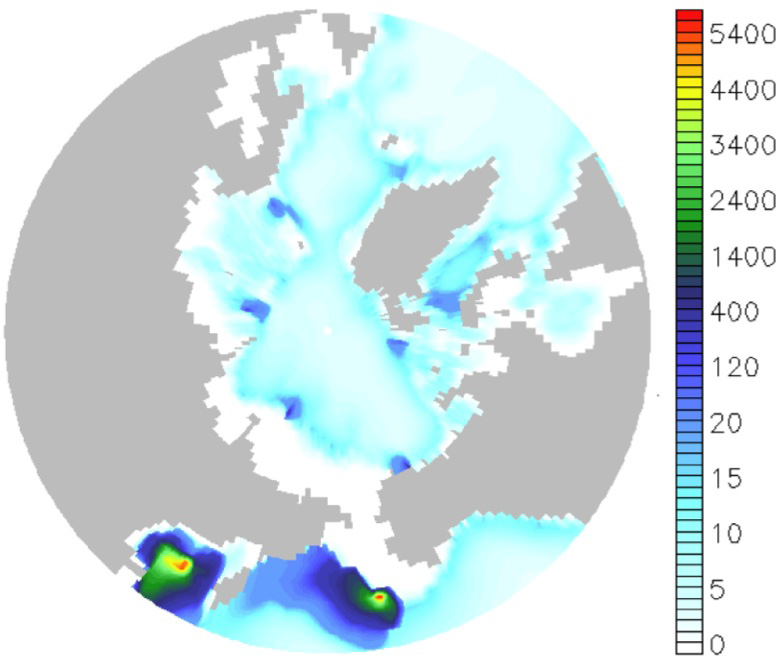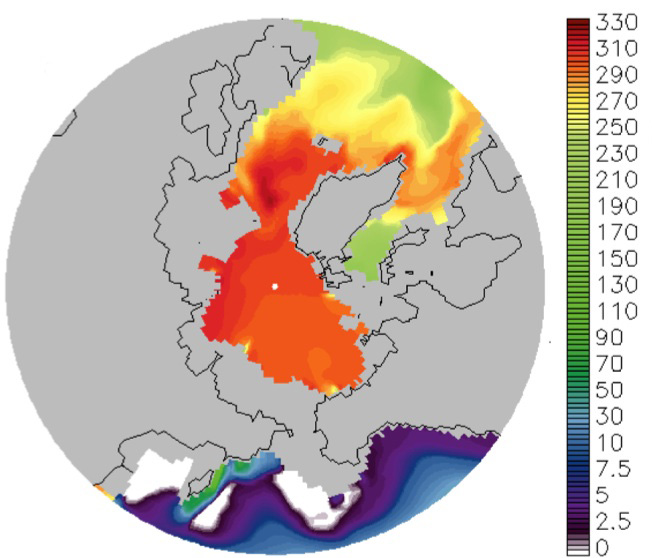A two-part study by scientists from the U.S Department of Energy’s Lawrence Berkeley National Laboratory (Berkeley Lab) and Los Alamos National Laboratory paints one of the most detailed pictures yet of how climate change could impact millions of tons of methane frozen in sediment beneath the Arctic Ocean. Methane is one of the most potent greenhouse gases.

This image, from a simulation in which oxygen levels were limited, reveals methane concentration in the Arctic Ocean after 30 years of clathrate dissociation due to ocean warming. The colors indicate depth-integrated methane concentration in millimoles per square meter. The marine environment is no longer able to break down some of the methane, as indicated by spikes in methane concentration at all eight plumes, most notably at the plumes in the Okhotsk Sea and Bering Sea at the bottom of the image. Further research will explore how much of this methane will reach the surface. North America is on the right, Russia is on the left.
The initial phase of the project found that buried deposits of clathrates, which are icy crystalline compounds that encase methane molecules, will break apart as the global temperature increases and the oceans warm.
In the second phase, the scientists found that methane would then seep into the Arctic Ocean and gradually overwhelm the marine environment’s ability to break down the gas. Supplies of oxygen, nutrients, and trace metals required by methane-eating microbes would dwindle year-by-year as more methane enters the water. After three decades of methane release, much of the methane may bubble to the surface — where it has the potential to accelerate climate change.
“Our simulation found that large methane releases erode the ocean’s ability to consume methane. At this scale, resource limitations come into play,” says Matthew Reagan of Berkeley Lab’s Earth Sciences Division. Reagan is a co-author of an article on this research that was published in a recent issue of the Journal of Geophysical Research. The initial results of the project were published last year in Geophysical Research Letters.
Their research counters the view held by some scientists that the oceans will always consume big plumes of methane. Indeed, small-scale methane releases have been seeping from seafloor vents for eons. In these cases, hungry ocean-dwelling microbes quickly oxidize most of the methane before it escapes into the atmosphere.
But this cycle will be disrupted if the Arctic region’s vast stores of clathrates break apart and unleash a rash of new methane seeps, the scientists found.
“Large-scale methane releases have a greater impact than we anticipated,” adds Reagan. “When this happens, microbes cannot consume all of the methane because there isn’t enough oxygen to fuel them.”
Their finding is based on a first-of-its-kind combination of two computer models. One model, developed by Berkeley Lab’s George Moridis in 2008, simulates methane release rates from warming clathrates. Next, these methane release estimates were applied to a marine biochemistry and ocean circulation model developed by Los Alamos National Lab’s Scott Elliott and Matthew Maltrud.

This image reveals simulated dissolved oxygen concentration, in micromoles, at a depth of 300 meters after 30 years of clathrate dissociation. Regions of severe oxygen depletion are indicated by white and purple shades.
The scientists plugged initial conditions into the simulation, such as the ocean’s background concentration of methane and seabed fluid flow. They then sprinkled a few hypothetical methane plumes around the Arctic continental shelf and in the Okhotsk Sea and Bering Sea. These areas hold extensive shallow clathrate deposits that are considered by scientists to be very susceptible to instability during the first few decades of global warming. In fact, some may already be dissociating.
They turned on the methane plumes and ran the simulation for three decades to predict what would happen during the early stages of climate change-driven ocean warming.
The result is a scenario that could be all-too real in the future: In some places, such as near plumes in the Okhotsk Sea and Bering Sea, the oxygen level plummets. Localized acidification also sets in. The environment becomes inhospitable for many organisms, including microbes that like to consume methane.
“The amount of methane entering the ocean is huge and it changes the water chemistry dramatically,” says Reagan. “It consumes oxygen, the microbes stop eating, and methane can reach the surface.”
The scientists hope to conduct further simulations to better estimate the amount of methane, now locked in clathrates under the Arctic Ocean, which could reach the atmosphere due to ocean warming.
This research was supported in part by the DOE Office of Science.
Lawrence Berkeley National Laboratory addresses the world’s most urgent scientific challenges by advancing sustainable energy, protecting human health, creating new materials, and revealing the origin and fate of the universe. Founded in 1931, Berkeley Lab’s scientific expertise has been recognized with 12 Nobel prizes. The University of California manages Berkeley Lab for the U.S. Department of Energy’s Office of Science. For more, visit www.lbl.gov.
Additional information:
- “Marine methane cycle simulations for the period of early global warming,” is published in the Jan. 28, 2011 issue of Journal of Geophysical Research.
- “Geochemistry of Clathrate-Derived Methane in Arctic Ocean Waters,” was published in the June 26, 2010 issue of Geophysical Research Letters.